African Wild Dog Profile
The African wild dog, sometimes referred to as the African painted wolf, painted dog or the cape hunting dog, is a medium sized pack-hunting dog found only in Africa. These striking animals are known as one of the most efficient and specialised hunters in the habitats in which they are found.
African wild dogs are most closely related to wolves and share many similarities with them. They have complex social structures and capture their prey through exceptional teamwork and excellent endurance.
The coat pattern of each wild dog is unique to itself, much like a humans’ fingerprint. They have relatively large heads, very big ears and long legs; all of which helps when hunting and capturing their prey. Their coat pattern is tricoloured, consisting of patches of black, white and brown/tan. All wild dogs have black muzzles and a white tip on their tails.
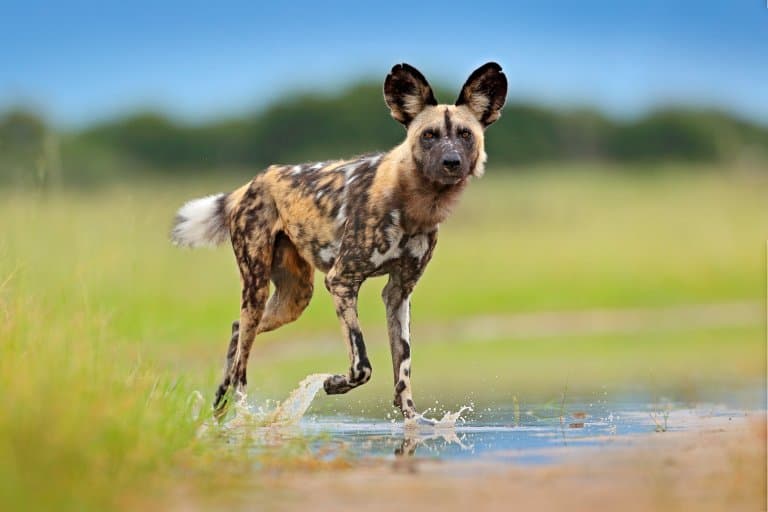
African Wild Dog Facts Overview
| Habitat: | Found in many habitats ranging from open savannah to dense woodlands |
| Location: | Sub-Saharan Africa, but very fragmented |
| Lifespan: | Around 10 years in the wild |
| Size: | Height 60 – 75cm |
| Weight: | 18 – 36 kg |
| Color: | Patches of brown, white and black with a dark, heavy-looking head and long legs |
| Diet: | Almost exclusively carnivorous, but will eat grass occasionally |
| Predators: | Very few natural predators, but pups are sometimes preyed upon by hyenas and lions |
| Top Speed: | Around 66 kph (41 mph) |
| No. of Species: |
1 |
| Conservation Status: |
Endangered |
African wild dogs are incredibly social animals and can live in packs of up to 60 individuals. The pack is led by a male and female breeding pair, with all other individuals helping with hunting as well as taking care of the young pups.
They have huge ranges, extending up to 2000km2 and require this vast area in order to hunt their prey. The African wild dog is an excellent hunter and has one of the most successful hunting strategies of all large predators. What makes them such effective hunters is their incredible endurance and ability to work as a team.
The pack runs their prey to exhaustion and when the prey begins to tire and run back on itself, other individuals in the pack are able to intercept and pull the prey down. This is no easy task as wild dogs will hunt animals as big as wildebeest. This can mean up to 21 dogs may be needed to pull the animal to the ground.
African wild dogs live in and around underground dens, though usually only the pups and parents sleep underground. They are almost strictly diurnal and therefore spend the night in relative safety away from larger predators.
Though the breeding pair are leaders of the pack, all other individuals are part of a hierarchy system and this determines when they get access to captured prey and the preferred sleeping areas.
Despite this strict system, wild dogs are very docile with one another and greet each other with much enthusiasm if they have been apart for any length of time. After a hunt some pack members will regurgitate food for not only pups, but even sick and injured dogs that remained at the den.
Historically, African wild dogs roamed across much of Africa, however their numbers have been in rapid decline for many years and they are classified as endangered.
This is in part due to the encroachment of humans into their range but also through the transmission of canine diseases from feral and domestic dogs is particularly devastating to the species. Thankfully they are now a protected species in much of their range and conservationists are aiming to increase their numbers and dispersal across Africa. 1
Interesting African Wild Dog Facts
1. African Wild Dogs are the second largest canid in the world
By body mass, only the gray wolf is larger than the African wild dog.
They are the largest wild canine in Africa, and can grow up to 75cm in height and weigh as much as 36kg.

2. African Wild Dogs mainly select their prey by sight
Despite having such large ears, wild dogs most often look for injured or young prey when hunting. They choose which animal would be the easiest target before beginning the chase. 2
3. They have incredible adaptations for hunting
They possess an athletic skeleton structure and one less digit on their forefeet, which both contribute to helping this dog take long strides and reach great speeds when hunting.
They are able to clock speeds of 66 kph (41 mph) and more impressively, continue chasing prey until for up to 60mins at a time, until their prey is exhausted.
Packs of African wild dogs hunt greater kudu, gazelle, impala, springbok and zebra, with a 60% success rate for kills which is impressive.
They have the largest premolars relative to body size of any living carnivoran except for the spotted hyena, which helps them chew their hypercarnivorous diet.
4. They show many differences from other dog-like species
Rather than fighting to settle disputes or food rights, African wild dogs communicate through various facial and vocal signals so as to avoid conflict.
This is very important as the survival of the pack relies on teamwork from all members. They also do not scent mark their territory, usually only around their den, unlike other canine species.
5. After capturing their pray, wild dogs will allow scavengers to eat at the kill
African wild dogs do not waste energy chasing away vultures, jackals and other scavengers. They eat extremely quickly so as to not encounter larger predators such as lions. 3
6. Hyenas and wild dogs are bitter rivals
Though hyenas do not prey on wild dogs, they do occasionally kill cubs and try to steal food from them. Wild dogs do not tolerate hyenas in their vicinity and will mob them; biting at their ankles and flanks before chasing them away.
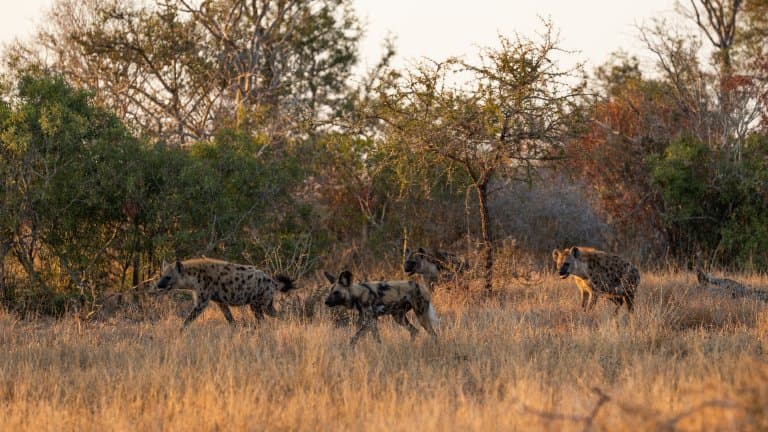
7. Females leave the pack upon reaching maturity and males remain
Unlike many other social mammals, it is the females that leave the pack when they reach sexual maturity. This prevents inbreeding and male-only packs are able create larger packs with those females which have left their original group. 4
8. The number of dogs in the pack is carefully controlled
As it is only the dominant pair that breed in a pack, only one female produces a litter. This is very important due the fact that the pack would not be able to feed all the pups if more litters were produced. 5
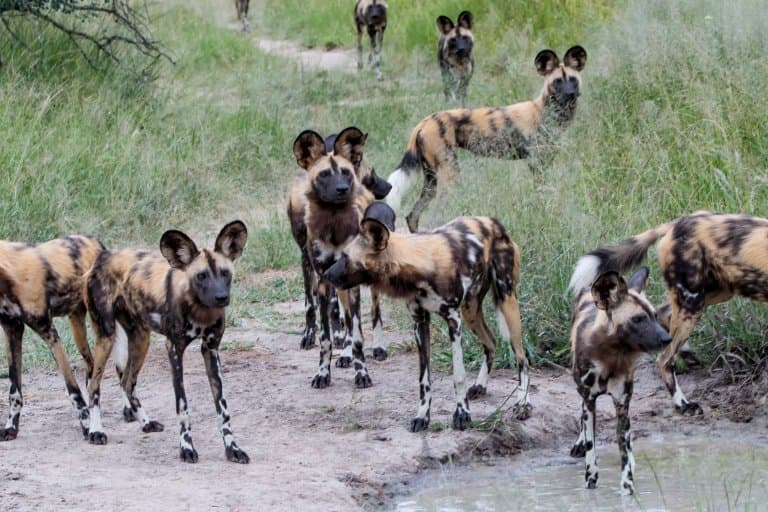
9. African wild dogs produce a particularly strong body odour
People observing wild dogs often remark on the strong smell they produce.
This is likely a mechanism to ensure individuals are able to find one another after a long chase, as well as being able to recognise different members of the pack.
10. Young wild dogs learn to hunt from an early age
Even at 7 weeks old, pups will attempt to follow the pack on a hunt, before an adult leads them back to the den.
Once they reach approximately 10 weeks old, the pack leaves the den and the pups follow them on hunts, learning the necessary skills required in the chase.
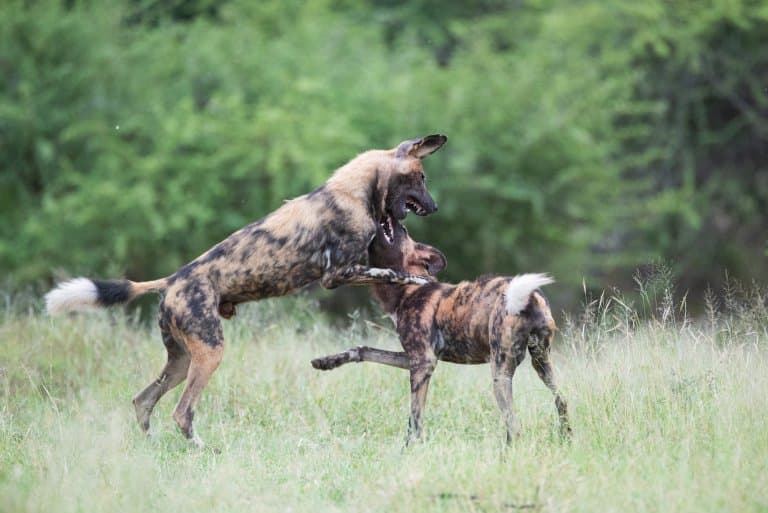
11. The scientific name, Lycaon pictus, means “Painted Wolf”
Their unique, tricoloured coats and wolf-like traits led to the wild dog being given the Latin name meaning “Painted Wolf”. 6
12. The African Wild dog is one of the most endangered carnivores in the world
Wild dogs rely on large areas to hunt. As these areas have been broken up into smaller sections, wild dog numbers have dwindled.
On top of this, they now come into more contact with domestic dogs, leading to transmission of diseases which can kill and wipe out entire packs.
It’s estimated that there are fewer than 6,600 adult African wild dogs today.
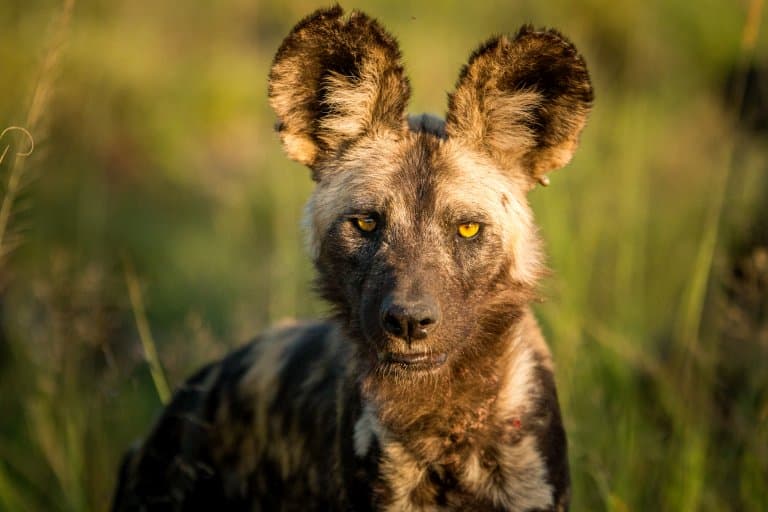
African Wild Dog Fact-File Summary
Scientific Classification
| Kingdom: | Animalia |
| Phylum: | Chordata |
| Class: | Mammalia |
| Order: | Carnivora |
| Family: | Canidae |
| Genus: | Lycaon |
| Species Name: | Lycaon Pictus |
Fact Sources & References
- Ginsberg, Joshua R, “The African wild dog: status survey and conservation action plan”, IUCN.
- “AFRICAN WILD DOG Lycaon pictus”, Canid Specialist Group.
- “African Wild Dog Facts”, World Wild Life.
- Michael Mulheisen, “Lycaon pictus African wild dog”, Animal Diversity Web.
- Franck Courchamp (2001), “Crucial important pack size in the African wild dog Lycaon pictus”, Research Gate.
- “What’s in a name? Why we call them painted wolves”, BBC Earth.
